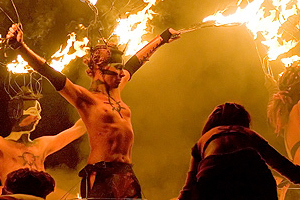 Beltane (or Beltain) is the Celtic festival of fire. It is usually celebrated on 1 May or around the midpoint from the spring equinox to the summer solstice. It marks the start of summer and celebrates fertility. It originated in ancient Scotland, Ireland and the Isle of Man.
Beltane (or Beltain) is the Celtic festival of fire. It is usually celebrated on 1 May or around the midpoint from the spring equinox to the summer solstice. It marks the start of summer and celebrates fertility. It originated in ancient Scotland, Ireland and the Isle of Man.
Nowadays, Beltane is popular with its modern versions. If you – our dear student – have the opportunity, go to the biggest Beltane celebrations in Edinburgh and Thornborough in Yorkshire. Another popular venue is the Butser Ancient Farm in Hampshire where the traditional 30-foot Wicker Man is burned at sunset.
Our dear students, before you go to the Beltane festivities, brush up on the origins and significance behind the rituals and practices. Read on what we at Essay Writer have put together. If essay writing problems hinder you from enjoying the celebrations, we will take care of it for you.
Etymology
Beltane is the Gaelic May Day festival in Anglican terms. The Old Irish word “Beltaine” is derived from a Common Celtic word that means “bright fire.” Traditionally, it was widely observed throughout Ireland, Scotland and the Isle of Man. This event is associated with important occurrences in Irish mythology, as accounted in the early Irish literature.
Beltane signals the start of summer. At this time, cattle were driven out to the summer pastures and so, to protect and pray for the growth of these cattle, the crops and themselves, the people performed rituals. The rituals include special bonfires which flames, smoke and ashes were believed to have the power to protect.
Rituals
In the rituals, the people with their cattle walked around the bonfire or between two bonfires. Sometimes, they leapt over the flames or embers. Household fires were put out and re-lit from the bonfire of the Beltane. The bonfire events included feasts. A portion of the food and drink was offered to the aos si, the supernatural race in the Irish and Scottish mythology. They are like fairies or elves.
May Flowers, May Bushes, Beltane Dew, Wells and Springs
Because yellow May flowers resemble fire, they were decorated on doors, windows, byres and the cattle. Making a May Bush – which is a thorn bush decorated with flowers, ribbons and bright shells – was practiced in some parts of Ireland. Some people visited holy wells or sacred spring which is a spring or other small body of water revered either in a Pagan or Christian content, usually both. Women believed that Beltane dew can improve their beauty and keep them young. In other parts of Great Britain and Europe, these practices were part of May Day or Midsummer festivals.
Evolution of Practice
By the 1940s to the 1950s, Beltane was scarcely celebrated. Nevertheless in some places, selected Beltane practices were continued. More so, the event has been revived as a cultural celebration. Towards the end of the 1990s, Celtic neopagans and Wiccans used Beltane practices as basis for their religious holiday celebrations. For neopagans in the Southern Hemisphere, Beltane falls around 1 November.
Begin the Summer with Beltane
Now, our dear students, you can go celebrate the start of summer at Beltane events with refreshed knowledge of the etymology, significance, rituals, practices and evolution of Beltane. Thank you for giving Essay Writer the pleasure of sharing with you such information. Again, we are always here to give you academic writing help and more.
 English
English 中文
中文
